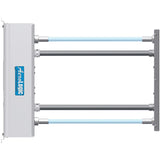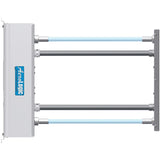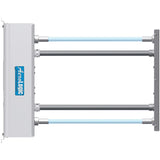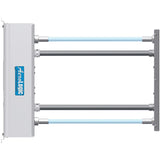How UVC Lighting Can Help Make Public Gatherings Safer
Posted by Nick on for ProLampSales

One of the concerns about reopening the economy is that, if large gatherings are allowed again, the COVID-19 strain of coronavirus may spread rapidly.
This is a legitimate concern as historical outbreaks of serious or deadly diseases have occurred in places of large assembly where one person exposed an entire population.
But with the greater awareness of sanitizing air and surfaces, UVC lighting systems can provide some protection and mitigate the risks of allowing public gatherings again in concert halls, sports stadiums, theaters, gyms, churches, shopping malls, and other venues.
Historical Outbreaks
1976 - Legionnaire's Disease
In the 1976 Legionnaire's Disease outbreak at the Bellevue-Strattford Hotel in Philadelphia, twenty-nine people died after being exposed to the Legionella bacterium.
The bacteria was found to be breeding in the cooling tower of a hotel's air conditioning unit. The HVAC system spread the bacteria throughout the building, exposing 2,000 American Legion convention attendees.
Cooling towers and coils, as well as building HVAC systems in general, are one of the more fertile breeding grounds for harmful pathogens in commercial buildings. There are UVC units that are specifically made to disinfect cooling coils.
1991 - Measles
At the International Special Olympics Games in 1991, a single track and field athlete from Argentina was the source of at least sixteen cases of measles.
This one athlete spread the bug in three settings that researchers tracked.
- The opening ceremonies
- Track and field events
- First aid stations
According to the researchers of this incident, "the risk of indigenous measles transmission associated with international events in the United States must be considered, even in areas without recent measles activity. Moreover, the dynamic airborne transmission of measles illustrates the potential for transmission in the absence of a recognized exposure."
As sports stadiums reopen and amateur and professional leagues begin holding events again, potential spread of airborne pathogens will be uppermost in the minds of attendees, facility managers, and league administrators.
1999 - Tuberculosis
Many churches, synagogues, and mosques have gone to online-only services during the coronavirus outbreak. There can be large risks in resuming services, as numerous studies have shown that churches are one social activity where pathogens can spread from family to family.
An outbreak of tuberculosis in 1999 was spread in one family and then to other families through church visits. While TB usually spreads through a household or family network, it can also be spread over longer time periods and through social connections inside a community.
UVC Lighting to Mitigate Airborne Pathogen Spread
These are just three examples of dangerous and potentially deadly pathogens being spread (or spread further) through social connections. There are many more examples of one person or family spreading a disease to many other people.
It is this fear that is contributing to the closing of "non-essential" businesses and gatherings.
One side effect of the COVID-19 outbreak and response has been increasing awareness of air and surface sanitization, including ultraviolet UVC germicidal light to deactivate bacteria, viruses, mold, and fungus.
UVC fixtures use fluorescent light bulbs (either tubes or CFLs) in a wide range of sizes and outputs, and can be used in different configurations to help prevent the spread of pathogens in social gathering places.
Let's look at a few options for UVC disinfection in large occupied spaces like sports stadiums, malls, or places of worship.
In-Duct HVAC
For buildings with central HVAC units, in-duct UV germicidal fixtures make the most sense. As air circulates in the building, it is continuously disinfected.
Especially in larger buildings, airborne transmission may be the primary method by which people are exposed to pathogens.
In the case of the Legionnaire's Disease outbreak, the cooling tower was the origin of the bacteria. Cooling coil UVC units can reduce microbes and increase energy efficiency in buildings that are susceptible to build-up of harmful microbes.
Upper Room Air
Commonly, sports stadiums, gymnasiums, concert venues, theaters, malls, and churches have areas with high ceilings. These are excellent spaces for upper air UVC units which provide continuous disinfection of air in that room.
Upper air units rely on the convection of air in the room to provide disinfection. As hot air rises and cool air falls, a natural circulation occurs. Whether air is being pumped in from ducts or rising as a result of convection, these units can deactivate harmful pathogens as they pass through the area of dosage of the system.
Depending on the size and height of the area, these fixtures can be mounted in several locations and use high-output bulbs to provide maximum disinfection.
Handheld Spot UVC
For areas like bathrooms which may see a lot of short-term traffic, smaller handheld UVC units carried by cleaning and maintenance workers can be utilized.
Depending on the strength of the equipment, it may take 5-30 seconds to disinfect areas, but this should be considered as a supplement to existing cleaning processes, especially for areas that are hard to reach with other cleaning agents.
When Places Reopen, Will People Trust Them?
When large gathering places reopen to the public, people may only slowly return to them. Improving existing cleaning processes is one way to reassure the public, but installing UV germicidal air/surface systems could provide even more confidence.
Disinfecting air as it circulates through a building or space is not an easy task. HEPA air filters can help, but not all of them filter out small organisms like viruses and bacteria. And they won't help if the central ventilation system is the source of the bacteria, as in the case of contaminated cooling coils.
This is why ultraviolet germicidal technology has been used in commercial buildings and hospitals in the past, with great success in reducing infections and illnesses.
In the future, such systems should see a wider installation base -- because they can give the public confidence that businesses are doing everything they can to keep an environment clean, and because UVC is effective at deactivating harmful pathogens.
Featured Products (View All)
- 0 Comments
- Posted in Health, Ultraviolet Light
0 Comments




